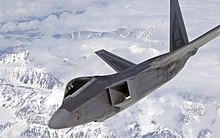Diverterless supersonic inlet
This article needs additional citations for verification. (November 2011) |

A diverterless supersonic inlet (DSI) is a type of jet engine air intake used by some modern combat aircraft to control air flow into their engines. It consists of a "bump" and a forward-swept inlet cowl, which work together to divert boundary layer airflow away from the aircraft's engine. This eliminates the need for a splitter plate, while compressing the air to slow it down from supersonic to subsonic speeds. The DSI can be used to replace conventional methods of controlling supersonic and boundary-layer airflow.
DSIs can be used to replace the intake ramp and inlet cone, which are more complex, heavy and expensive.[1]
History
Initial development in this area was done by Grumman, who made an alteration to the Grumman F11F-1F Super Tiger inlet, to replace a splitter plate with a bump.They still used bleed air holes on the bump.[2] Further research into the DSI was done by Lockheed Martin in the early 1990s. The first Lockheed DSI was flown on 11 December 1996, installed on a F-16 Block 30 fighter and replacing aircraft's original intake diverter. The modified F-16 demonstrated a maximum speed of Mach 2.0 (Mach 2.0 is the F-16's clean certified maximum speed) and handling characteristics similar to a normal F-16. It was also shown that subsonic specific excess power was slightly improved.
A DSI was later incorporated into the design of the Lockheed Martin F-35 Lightning II. The DSI concept was introduced into the JAST/JSF program as a trade study item in mid-1994. It was compared with a traditional "caret" style inlet. The trade studies involved additional CFD, testing, and weight and cost analyses. The new inlet earned its way into the JSF design after proving to be thirty percent lighter and showing lower production and maintenance costs over traditional inlets while still meeting all performance requirements. [1]
Technology
Inlets

When an aircraft is flying, the speed of the air relative to the engine is equal to the plane's flight speed. However, the airflow into the engine compressor chamber needs to be subsonic, and at the optimal speed and volume so as to offer maximum thrust. The inlet sits upstream of the compressor and has a strong influence on engine net thrust.
The speed of air entering the compressor of a normal jet engine must not be supersonic, even for supersonic aircraft. Current turbine engines are unable to handle the shock waves associated with supersonic airflow, and might be damaged or suffer loss of thrust if supersonic airflow passes through compressor blades. Thus, on aircraft traveling above the speed of sound, the airflow must be slowed down to subsonic speeds before entering the engine. In modern jet aircraft, this is done in a variety of ways through design of the inlet.[3]
A well-designed inlet straightens out the flow, and feeds the compressor with turbulence-free air at a relatively constant speed and volume. This is not difficult to achieve in subsonic aircraft such as passenger jets, which do not perform high-speed, high-G maneuvers that lead to turbulent airflow.[4] Consequently, subsonic aircraft have simple, and shorter inlets.[5]
On supersonic military jets, the inlets are usually much more complex and use shock waves to slow down the air, and movable internal vanes to shape and control the flow. The complexity of these inlets increases with an increase in top speed. Planes with top speeds over Mach 2 require much more elaborate inlet designs, which limits most modern combat jets to a top speed of Mach 2.
Diverterless Inlets
The DSI bump functions as a compression surface and creates a pressure distribution that prevents the majority of the boundary layer air from entering the inlet at speeds up to Mach 2. In essence, the DSI does away with complex and heavy mechanical systems.
Benefits
Weight and complexity reduction
DSIs completely eliminates all moving parts. This results in an inlet that is far less complex than earlier diverter-plate inlets. The removal of moving parts also lightens the overall weight of the aircraft. Traditional aircraft inlets contain many moving parts and are much heavier than newer diverterless inlets.[6]
Stealth
DSIs also crucially improve the aircraft's very-low-observable characteristics (by eliminating radar reflections between the diverter and the aircraft's skin).[1] Additionally, the "bump" surface reduces the engine's exposure to radar, significantly reducing a strong source of radar reflection[7] because they provide an additional shielding of engine fans against radar waves.
Analysts have noted that the DSI reduces the need for application of radar-absorbent materials.[1][8]
List of Aircraft with DSI
- Lockheed Martin F-35 Lightning II
- Chengdu J-10B[9]
- Chengdu J-20
- Shenyang J-31
- JF-17 Thunder
- Guizhou JL-9[10][11]
References
- ^ a b c d Hehs, Eric (15 July 2000). "JSF Diverterless Supersonic Inlet". Code One magazine. Lockheed Martin. Retrieved 11 February 2011.
- ^ [Naval Fighters 44, F-11F Supertiger pg 37, by Corwin ( Corky ) Meyer]
- ^ http://kakunhome.tripod.com/aviation.htm
- ^ University presentation on JSF Program
- ^ Inlet Design and Inlet types, NASA.
- ^ F-35 JSF Technology
- ^ "Fast History: Lockheed's Diverterless Supersonic Inlet Testbed F-16" aviationintel.com, 13 January 2013
- ^ "J-20's Stealth Signature Poses Interesting Unknowns". Aviation Week. Retrieved 13 January 2013
- ^ "歼-10B改进型". AirForceWorld.com.
- ^ "JL-9 Trainer Jet gets DSI inlet, Guizhou China". AirForceWorld.com. Retrieved 29 Aug 2011.
- ^ "Paris Air Show 2011 - Naval air trainer unveiled by Chinese media". home.janes.com, 15 February 2012.
